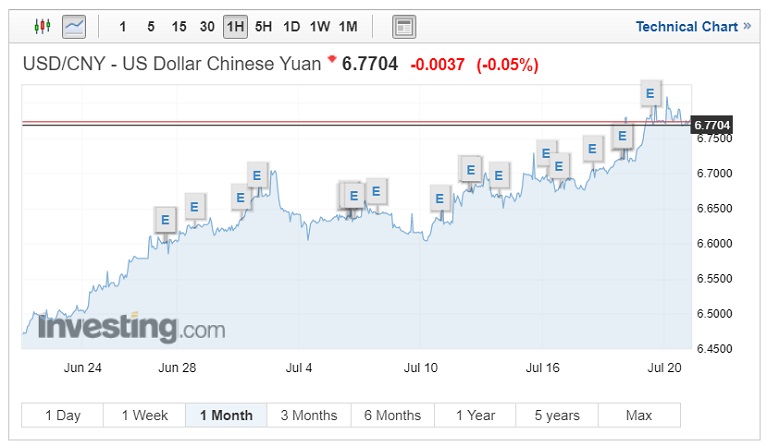US Dollar continued its ascent against the Yuan this week following months of trade talk which has affected both currencies. This week the President signalled that he had concluded plans to implement tariffs totalling $500 billion on Chinese imports to the US. Whilst the comments caused the US Dollar to depreciate against the majority of currencies, notably safe havens such as CHF and JPY the USD/CNY have continued to strengthen. Investors are now believing that the ‘trade war’ could also be morphing slowly into a currency war with both superpowers trying to weaken their currencies.

Trump plans $500 billion in tariffs on China
Roughly $500 billion of tradable goods were imported into the US in 2017, creating a trade deficit of $376 billion. Trump plans to implement a much tougher stance on this, adopting a protectionist mentality to trade deals moving forward. Whilst many of his policies may have been interpreted as bluster, it appears Trump is keen to level the trade playing field. Just this month the placed tariffs on $34 billion Chinese imported goods, China quickly intervened adding levies to the same amount of US goods imported into China.
The tit-for-tat stance is worrying economists who believe higher levies will begin disrupting supply chains, increase production cost and be harmful to the global economy.
The President not supporting higher interest rates
This week also saw the Federal reserve hint at future rates rise this year a stance that the President clearly isn’t thrilled about. In the latest FED speech, Jerome Powell stated that he anticipated seeing two more years of growth in the US economy. The comments propelled the USD index to a 3-week high, enjoying gains against a multitude of currencies.
When challenged on the risks to the US economy, these including the potential of a trade war and bond yield spreads which historically have signalled recession Powell appeared unconcerned.
Whilst Powell didn’t sidestep the issue of the snowballing trade war, some have criticised his tone as being dismissive. Touching upon the issue Powell illustrated that if the increased tariffs would translate into higher inflation they could begin to cause an issue. He added that business owners across the US were voicing their concerns about tariff plans. Providing assurance Powell said the FED felt that they had the tools to deal with this potential issue.
On the subject of the US bond yield curve, more precisely an inverted yield curve. The FED believes that although historically an inverted curve and decrease in yield spread typically lead to recession, this time will be different. Powell focused on the importance of a neutral rate which allows the FED to forecast the market’s interpretation, and would essentially allow the FED to find an ideal.
After the two-day QA with Congress, the ever-vocal President Trump voiced his concerns at the increase in interest rates during a CNBC interview on squawk box saying that:
“Because we go up and every time you go up they want to raise rates again. I don’t really — I am not happy about it. But at the same time, I’m letting them do what they feel is best.”
His comments have caused their own controversy as historically as with judicial process the President shouldn’t comment on the Fiscal process. Trump’s comments contravene the FED’s independence, his comments leaving Powell in a challenging scenario of buckling under trumps pressure or following the FED’s free will.
The effect on China’s export business
Despite the rising tension and lack of goodwill between the US and China, Chinese exports remain at significant levels. Last month China reported export sales totalling $42.6 Billion, a year on year increase of 12.6%. Likewise, imports from the US to China also grew increasing by 9.6%, totalling $13.7 Billion.
China is the second largest trading partner after the EU. Whilst only one month into the new US tariffs policy the figures will show signs of encouragement, especially if the USD/CNY rates continue in the current trend. Despite fears that Chinese appetite could be slowing US products currently remain unperturbed whereas Chinese imports from the EU have fallen 6.5%.
Are China likely to intervene?
In a word no. A devaluing Chinese Yuan will encourage exports as stronger currencies will go further affording importers greater buying power. On top of the Yuan’s natural FX fluctuation, China has the possibility of devaluing the CNY further. Since March USD/CNY has devalued roughly 8% then US importers would only see a slight price increase.
Essentially the more tariffs imposed by Trump the more the CNY FX price would decline therefore the US importer would only see a moderate increase in wholesale prices. Experts believe that this could equate to as little as a 2% increase.
Will the USD/CNY strength continue?
The USD/CNY will almost certainly continue to strengthen. Not just due to the rationale of further tariff’s correlating with a weaker yuan but also due to the FED’s glowing economy outlook.
Powell, despite Trump’s side comments, appears set of further US interest rate rises. In recent days the pair touched a year high, reaching USD/CNY 6.80. The PBOC (Peoples Bank of China) are slowly favouring the route of currency intervention. The weakening of the CNY is also having a strengthening effect on USD meaning that the Dollar is stronger against a number of other pairs. All of which spells out not just a trade war but a currency war. FX Markets be ready.
